Locksmiths in Lima in the 17th and 18th centuries
In the same publication as the above article, ethnologist Olle Homman also wrote about pull locks. As a complement to Erixon’s work, Homman’s essay focuses on the locksmiths themselves. He found that many smiths worked with the same type of lock, and on assignment of the Nordiska Museum he used their signatures, church archives and interviews to identify the locksmiths, find their family names, family farms and the periods when they worked.
Travelers through the parish, including Carl Linnaeus in 1734, Abraham Hülpher in 1757, and Sven Rinman in 1764, have all commented on how common it was for farmers to do their own smithing. All stated that the surest source of income for the people of the parish was making scythe blades, but no mention is made of locksmithing.
Homman has found that practically all locks signed IOS stayed within Lima Parish and its former chapel congregation, Transtrand. The fittings are dated between 1747 and 1761, and their markings show that the same lock types were made by several smiths. The signatures allowed Homman to compile a listing of smiths and their periods of activity.
The top two on the list above, Olof Nilsson and Lars Nilsson, were brothers from the Heigulugården farm in Risätra. They are also included in a more detailed list and presentation that Homman made of some of the locksmiths who were in highest demand and their closest family members in Lima. They do not seem to have had any competition, and since they were active for a long time, we can assume that smithing was probably profitable for them.
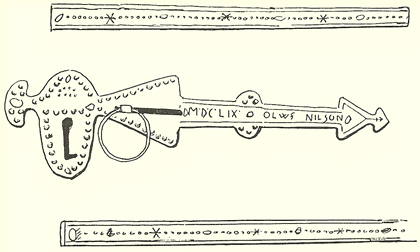 |
| Olof Nilsson’s signature and date on a lock fitting from Rönnäs in the parish of Leksand, Dalarna. Sketch by Olle Homman. |
Homman tells of Olof Nilsson’s and his brother Lars’ familial and working relationships, their signatures or marks, and the decorations on their locks. All smiths in the Heigulu family manufactured iron pull locks. In those days, the late 17th century, they were not able to sell their products through a third party, but had to sell directly from the smithy or travel themselves, mainly to the big fall and spring markets.
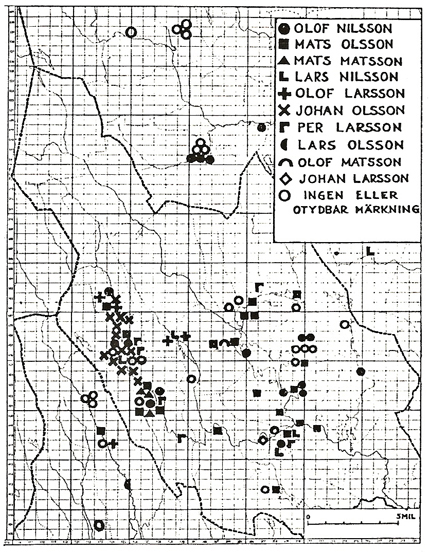 |
| Prevalence of Heigulu-family pull locks. Each character in the map corresponds to a lock. |
Homman also includes the other smiths in Lima, listing all information he could find in the church archives. He points out that it is not known how pull locks were made, or what the daily lives of the smiths were like. We do know that they were regular farmers at the same time, and that they did their smithing in late fall and winter when there was no work to be done in the fields. They could work in the smithies until late at night; in 1764, Rinman wrote that “to help him in the smithy the farmer uses his son or boy, or commonly his wife, who pumpes the bellows with her feet whilst attending to her sewing or spinning. When the iron is taken from the fire, she hangs her handiwork on a hook on the wall and takes up the hammer alongside the man until the iron is put back in the fire, when she returns to the previous occupation”. The Lima smithies did not have chimneys until well into the 20th century. The hearth lay along one of the long walls, with two bellows for an even flow of air and a hatch in the roof over the hearth with matching hatch on the opposite side of the roof that was opened or closed as needed.
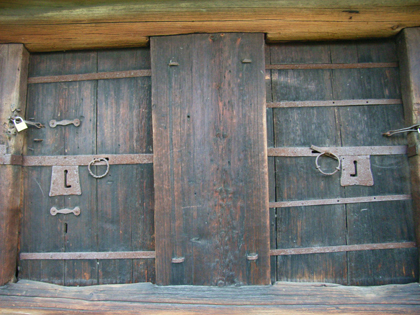 |
| Pull locks on the doors of the Kråkberg storage building at Hembyn in artist Anders Zorn’s collection of buildings in Mora. Note the difference between the pull rings. Photo by the author. |
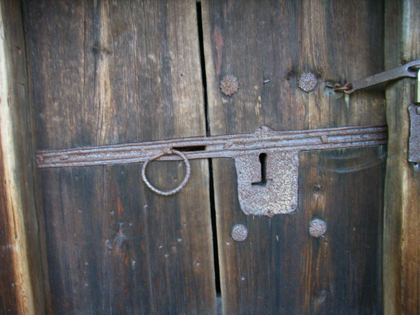 |
| Pull lock on one of the doors in artist Anders Zorn’s collection of buildings in Mora. Photo by the author. |
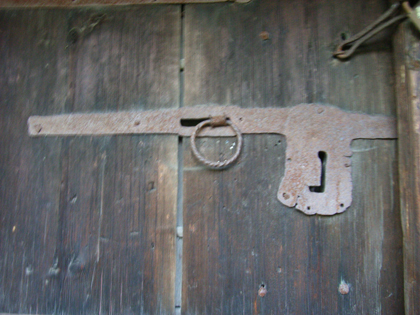 |
| Pull lock with a spiraled pull ring on one of Anders Zorn’s collection of buildings in Mora, Dalarna. Photo by the author. |
References
Erixon, Sigurd, “Ett ålderdomligt smide i Dalarna och dess härkomst”. Folk-liv 1942. Stockholm 1942.
Erixon, Sigurd, “På järnets fasta grund”. Låset förr och nu. Eskilstuna 1946.
Hellner, Brynolf, ”Järnsmidet i vasatidens dekorativa konst”. Stockholm 1948.
Homman, Olle, “Låssmeder o Lima 16-1700-talen”, Folk-liv 1942. Stockholm1942.
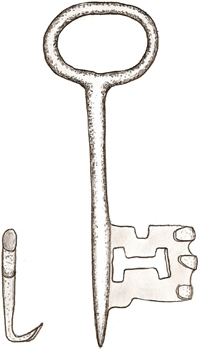 |
| Key to a pull lock. Sketch by the author. |